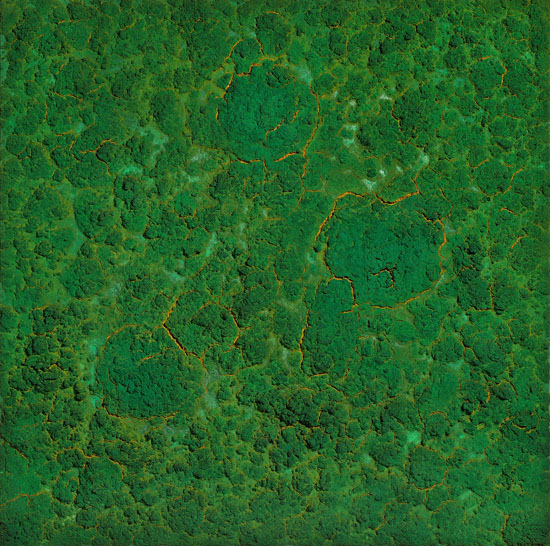Exhibitions
Archive

Bosco Sodi
EIGEN + ART Lab
October 31 through December 14, 2013
Opening: October 31, 2013, 5-9 pm
Bosco Sodi
Terra Ignota
Terra Ignota is the term used in cartography for regions that have not yet been documented and described: new land on which no foot has been set and whose precise dimensions, vegetation and population are completely unknown.
In a certain way, Bosco Sodi’s work is a journey of discovery treading new territory, planned well in advance, but without knowing the exact outcome. Once the preparations for the trip are made, the material found, and the form of the canvases determined, the pictures develop as if on their own within a structure of external conditions. Sodi provides the external framework, decides on the color of the pigments – in his most recent works, a lush green with fissures of earthy orange running through it – and determines the format of the canvas and the amount of material that he’ll form with his hands directly on the canvas; but what happens after that is an autonomous process that the artist cannot steer. Even though he always works with the same materials – cellulose, sawdust, glue, and pigments – each picture and each sculpture is exposed to a natural process that is influenced not only by the climate and temperature, but also by the characteristics of the sawdust and the origin of the pigments. Over a period of several months, they thereby develop a life of their own, with furrows and crusts growing in the pictures and changing the color and surface. Due to their density and the raw imperfection of the material, they take on a presence and weight that lets them stand like organic bodies in the space and emit a powerful energy. Without presenting any figuration or aid to interpretation, they evoke very elemental associations and archaic impressions; neither title or signature aim to distract the viewer from his instinctive feelings; all that remains is the effect of the color, the haptic quality of the organic material, the volumes in space, and an ephemeral beauty that comes very close to a universal understanding of natural sublimity.

Although Bosco Sodi determines a pigment and a color within a series and often also within an exhibition and at first glance the size and format of the pictures seems like a repetitive sequence, no picture is like another or can be created or copied a second time; Sodi thus delegates responsibility for the result completely to the external factors.
A touch of impermanence lies below the fissured surface, which itself requires a certain time to form in the first place. The pictures, which Sodi calls "organic animals", do not claim to last for eternity; their natural components may change over the years. This too is left to chance.
Along with the effect of the organic materiality, the power of natural color is a central aspect of Sodi's works. When we view Sodi's pictures, Wassily Kandinsky's theories on the effect of color have a surprising timeliness 100 years later:

“If one lets one’s eyes glide across a palette full of paint, there are two main results: 1. There is a purely physical effect, i.e., the beauty and other qualities of the paint enchant the eye itself. The viewer feels pleasure and joy, like a gourmet when he has a delicacy in his mouth. Or the eye is stimulated, like the palette by a well-seasoned food. It is also calmed or cooled, like a finger touching ice. These are all physical feelings, which, as such, can only be of brief duration. (...) Vermillion has the charm of flame (...) Keen lemon-yellow hurts the eye in time (...), the eye turns restless and seeks deepening and calm in blue or green. (…) But with higher development, this elemental effect evokes a deeper one that leads to an emotional upheaval. In this case, the second main effect of observing the color is present, i.e., its psychological effect. Here the psychological power of the color emerges, evoking a spiritual vibration. And the first, elemental physical power now becomes a path upon which the color reaches the soul. (...) In general, color is a power for directly influencing the soul. Color is the keyboard. The eyes are the hammers. The soul is the piano with many strings.“[1]
Like natural phenomena for which there are no explanations, so too Bosco Sodi’s pictures cannot be decoded, understood, or interpreted, but they trigger something that appeals to the senses directly, like the sight of an especially lushly green forest, the sea, or a rock formation. Just as one cannot see enough of a forest, a lake, or clouds in the sky, but rather finds one’s gaze enthralled, so too it gets caught in Bosco Sodi’s pictures without wearying.
Leoni Pfennig